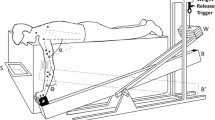Abstract
The aim of this study was, firstly, to confirm or refute the existence of circadian rhythms during several velocities of concentric action of the elbow flexor muscles and, secondly, to compare the characteristics of these circadian rhythms with those obtained during isometric actions. Eight volunteer subjects participated in this study. The circadian rhythms were obtained from six test sessions (TS) carried out at different times of day over 6 days with only one TS a day. During each TS, oral temperature and the torque of the muscle action were measured. The subjects made, on an isokinetic ergometer, two maximal isokinetic concentric elbow flexions at five angular velocities (60, 120, 180, 240 and 300° · s−1) and at an angle of 60°. Torque-angular velocity relationships, which characterised the functioning of the muscle during concentric and isometric actions, were established for the different times of day. The values of the torque recorded at each of the angular velocities presented a clear circadian rhythm. After normalisation of the torque values, no significant differences were observed among the computed characteristics of the circadian rhythms obtained at different angular velocities. Since the circadian rhythms during isometric and concentric torque were the same, the characteristics of the circadian rhythms of the musculo-skeletal system can be studied using either type of muscle action. The results indicated that torque and temperature varied concomitantly during the day. Thus, the recording of body temperature allows one to estimate the times of occurrence of maximal and minimal values in the circadian rhythm of muscle torque.
Similar content being viewed by others
Author information
Authors and Affiliations
Additional information
Accepted: 10 October 2000
Rights and permissions
About this article
Cite this article
Gauthier, A., Davenne, D., Martin, A. et al. Time of day effects on isometric and isokinetic torque developed during elbow flexion in humans. Eur J Appl Physiol 84, 249–252 (2001). https://doi.org/10.1007/s004210170014
Issue Date:
DOI: https://doi.org/10.1007/s004210170014




